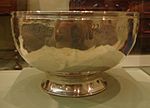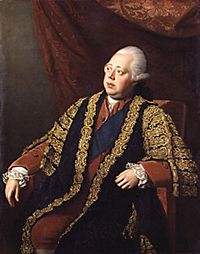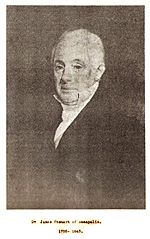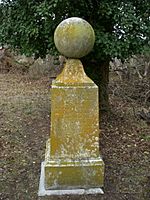George H. Steuart (politician) facts for kids
Quick facts for kids
George Hume Steuart
|
|
|---|---|
| Mayor of Annapolis | |
| In office 1759–1763 |
|
| Preceded by | John Brice, Jr. |
| Succeeded by | Daniel Dulany |
| Colonel of the Horse Militia | |
| Assumed office 1753 |
|
| Deputy Secretary of Maryland | |
| In office 1755–1756 |
|
| Judge of the Land Office | |
| In office 1755–1775 |
|
| Succeeded by | St George Peale |
| Personal details | |
| Born | c. 1700 Argaty, Perthshire, Scotland |
| Died | 1784 Perthshire, Scotland |
| Spouse | Ann Digges |
| Relations | Major General George H. Steuart (grandson) Richard Sprigg Steuart (grandson) Brigadier General George H. Steuart (great-grandson) |
| Residence | Dodon |
| Alma mater | University of Edinburgh |
| Occupation | Physician, planter, politician, soldier |
George Hume Steuart (1700–1784) was a Scottish doctor and a wealthy tobacco farmer. He was also a politician in colonial Maryland who remained loyal to the British King during the American Revolution.
Born in Perthshire, Scotland, Steuart moved to Maryland around 1721. He received support from the colony's owners, the Calvert family. This helped him get important jobs in the government. He became a rich landowner with properties in both Maryland and Scotland. He even served two terms as mayor of Annapolis.
When the American Revolution began, Steuart had to choose. He could either stay loyal to the British King or join the American rebels. In 1775, at age 75, he sailed back to Scotland. He said he "could not turn rebel in his old age." He stayed in Scotland until he died in 1784.
Contents
Early Life and Education
Steuart was born in Argaty, Scotland, around 1700. He was the second son of George Steuart and Mary Hume. His family was part of the Balquhidder Stewart clan, an old Scottish family.
It is likely that Steuart spoke both Gaelic and English. Gaelic was common for many people in his home area. English was also spoken, especially in the "low country" around Stirling.
Since his older brother would inherit the family lands, George studied medicine. He earned his medical degree from the University of Edinburgh. In 1721, he moved to Annapolis in the Maryland colony. There, he started his medical practice.
In the early 1700s, Maryland was mostly rural. Annapolis was a small town. In 1715, it had only 405 people. By 1730, its population grew to 776.
A Planter and Horse Breeder
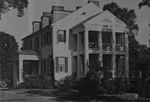
In 1747, Steuart bought a large estate called Dodon. It was located in Anne Arundel County, Maryland, near the Chesapeake Bay. At Dodon, Steuart grew tobacco. He also enjoyed horse racing.
His best racehorse was Dungannon. Steuart brought Dungannon from England to race against his rival, Charles Carroll of Annapolis. Carroll's son, Charles Carroll of Carrollton, later signed the Declaration of Independence.
Dungannon won the Annapolis Subscription Plate in May 1743. This was the first official horse race recorded in Maryland. The race took place in Parole. The original silver cup is now on display at the Baltimore Museum of Art.
Horse racing was a very important social event in the colony. Many wealthy gentlemen owned large groups of horses. George Washington, who would become the first U.S. President, attended early races. Steuart even hosted Washington at his home in Annapolis.
Wealthy people like Steuart lived very well. Their homes were large, surrounded by huge farms. These farms were worked by enslaved people. Their homes had expensive furniture and fine carriages.
Political Career
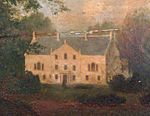
George Steuart was a Loyalist in politics. This meant he supported the British King. His interests were closely tied to the Calvert family. They were the owners of the Maryland colony.
In 1742, Charles Calvert, 5th Baron Baltimore sent his son, Benedict Swingate Calvert, to Maryland. The boy, who was about 10 or 20 years old, was placed in Steuart's care. He lived at Steuart's home in Annapolis and had a tutor.
Steuart gained a lot from the Calvert family's support. He held many important jobs in the colonial government:
- In 1753, he became a lieutenant-colonel in the Horse Militia.
- He was Deputy Secretary of Maryland from 1755 to 1756.
- He served two terms as Mayor of Annapolis, from 1759 to 1761 and from 1763 to 1764.
- He was a judge of the Land Office from 1755 to 1775. This office helped settle disagreements about land ownership.
- Steuart was also a member of the "Council of Twelve" and a judge in the Court of Admiralty.
Lord Baltimore even gave Steuart the nickname "Honest Steuart." However, his political rivals later used this name against him.
Politics in Maryland could be very heated. Records show that Steuart and his successor as mayor, Michael MacNamara, had to promise to keep the peace with each other.
In 1758, Steuart went back to Scotland. He inherited the estate of Argaty and other lands from his family. By 1761, he was back in Maryland. He worked as a Commissioner of the Loan Office, collecting taxes for the government.
The American Revolution
Rising Tensions
In the 1760s, relations between Britain and its American colonies worsened. Steuart remained a Loyalist. Many Scots, like him, remembered the harsh results of past rebellions against the King in Scotland. They did not want another rebellion.
However, Steuart, like other Marylanders, did not like the new taxes from London. In 1764, he traveled to England. He spoke to the British government in Westminster about these taxes.
His grandson, Richard Sprigg Steuart, later remembered this: "When he went over [to England] in 1764...he was asked by many Marylanders to visit Lord North, England's new finance minister. He was to talk about the taxes. Lord North listened politely and asked many questions. He seemed to agree with what Steuart said. Soon after, my Grandfather was happy to hear that this unpopular tax was removed."
Steuart's Loyalist views were opposed by people like Samuel Chase. Chase helped start the Sons of Liberty in Anne Arundel County. He was a strong opponent of the 1765 Stamp Act and later signed the Declaration of Independence.
In 1766, Chase publicly attacked Steuart and others. He accused them of being "busy, reckless" and "disturbers of the public peace." Chase said Steuart had "no merit, integrity or abilities" and was only chosen because of his connections to the colony's owners. These attacks made the political situation even more tense.
Choosing Sides in the War
War broke out in 1775. Owning land in both Scotland and Maryland caused problems for Steuart. His grandson explained: "He admired the American Colonies and believed their fight was fair. But even though he felt for his American friends, he said he could not become a rebel in his old age. He was 75 when the Revolution started...he would have lost his Scottish lands if he joined the Revolutionaries. So, he went to Scotland and saved his property there. He gave all his lands in Maryland to his wife [Ann]."
Ann Steuart stayed in America, even though she also supported the Loyalists. She never saw her husband again. She lived at Dodon until she died in 1814.
Her family, the Digges, were also Loyalists but stayed quiet. They were called "non-jurors" and paid double taxes. After the war, Ann lived comfortably. But she stayed home because her husband was called a "Tory" (a Loyalist) by some people. He was not truly a Tory, as he felt sad about every battle, calling it a "fratricidal war" (a war between brothers).
After the War
Steuart never returned to Maryland. He died in 1784 in Scotland, one year after the American Revolutionary War ended. He was buried in Kilmadock, Scotland. No pictures of him exist.
When he left Maryland, his estates in Anne Arundel County were about 4,100 acres (16.6 square kilometers). In 1780, these lands were given to his sons Charles and William for a small fee.
The Argaty estate in Scotland went to Steuart's oldest son, also named George Hume Steuart. This son also stayed loyal to the British King. The Argaty estate was sold in 1914. Today, it is part of a special area that protects red kite birds.
Family Life
In 1744, Steuart married Ann Digges (1721-1814) from Warburton Manor. She was the daughter of a planter named Charles Digges. Her mother was Susanna Maria (Lowe) Digges.
George and Ann Steuart had ten children. Six of them lived to be adults:
- George H Steuart (1747–1788), a doctor. He moved to Scotland in 1758. He changed his name to George Steuart Hume to inherit the Argaty estate.
- Susanna Steuart (1749–1774), who married Judge James Tilghman in 1769.
- Dr. Charles Mark Steuart (1750–1798), a doctor. In 1780, Charles Steuart married Elizabeth Calvert. Like his mother, Ann, Charles was a Loyalist. However, he was present with General George Washington at the Siege of Yorktown in 1781. He also served in The Flying Camp, a Patriot Militia group.
- David Steuart (1751–1814).
- William Steuart (1754–1839), a rich farmer who inherited Dodon.
- Dr. James Steuart (1755–1846), a doctor who served during the American Revolutionary War. He owned a farm at Sparrow's Point, Maryland. James Steuart was a strong supporter of the American cause. His son, Major General George H Steuart, fought in the War of 1812. His grandson, Brigadier General George H. Steuart, was a Confederate general in the American Civil War. He fought in battles like Gettysburg.
Religious Beliefs
Steuart was an Episcopalian, which is a type of Protestant Christian. His wife, Ann, was a Roman Catholic.
According to their grandson, Richard Sprigg Steuart: "Even though he and his excellent wife belonged to different churches, they never argued about religion. They found enough to believe in together to be good Christians. He trusted her so much that he asked her to raise his sons as Episcopalians. He knew there were political disadvantages to joining any other church."
Legacy
A stone monument called an obelisk at Dodon marks where Ann Digges and other family members are buried. The farm, though smaller now, is still home to Steuart's descendants today.
The unusual spelling of "Steuart" was common in the 1700s. Today, it is not used as much. However, Steuart's many descendants in North America still use this old spelling.
In 1955, a silver copy of the original Annapolis Subscription Plate was made. This "Dungannon Bowl" is a special trophy given to the winner of the annual Dixie Stakes. This is the oldest horse race in Maryland and the Mid-Atlantic states.
See also


